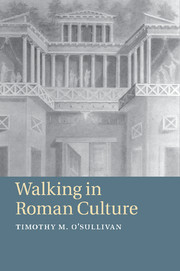Book contents
- Frontmatter
- Contents
- Figures
- Acknowledgements
- Abbreviations
- Introduction
- Chapter 1 The art of walking
- Chapter 2 Seneca on the mind in motion
- Chapter 3 Urban walkers on display
- Chapter 4 Cicero’s legs
- Chapter 5 Theoretical travels
- Chapter 6 Walking with Odysseus
- Conclusion
- Bibliography
- Subject index
- Index locorum
- References
Bibliography
Published online by Cambridge University Press: 05 August 2011
- Frontmatter
- Contents
- Figures
- Acknowledgements
- Abbreviations
- Introduction
- Chapter 1 The art of walking
- Chapter 2 Seneca on the mind in motion
- Chapter 3 Urban walkers on display
- Chapter 4 Cicero’s legs
- Chapter 5 Theoretical travels
- Chapter 6 Walking with Odysseus
- Conclusion
- Bibliography
- Subject index
- Index locorum
- References
- Type
- Chapter
- Information
- Walking in Roman Culture , pp. 158 - 175Publisher: Cambridge University PressPrint publication year: 2011



